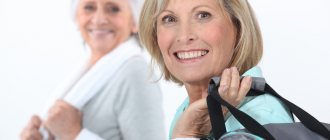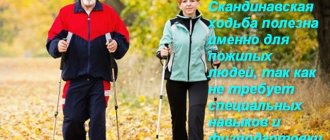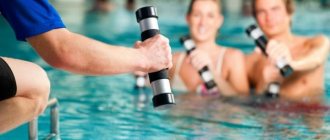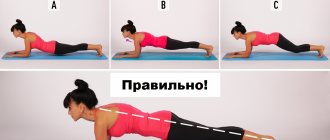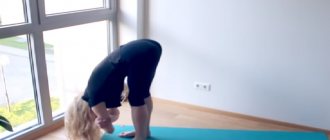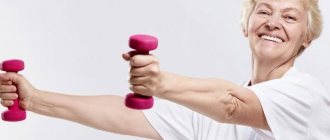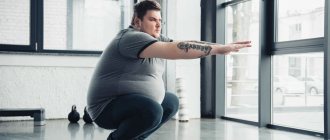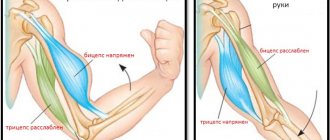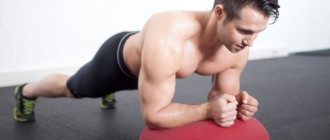The human body begins to age, starting from 26-28 years of age. These processes become especially intense after 50 years. In women, this period is marked by the onset of menopause, and in men, the decline of the body largely depends on the stabilization of decreased testosterone secretion, which for most occurs at the age of about 60 years.
Women and men age differently, which is why life extension programs, namely physical exercises for older men, are different from those for women.
After 60, it's time to take care of yourself and become a long-liver
It's never too late to start exercising. The information and video in this article are intended for older men (60-75) who have decided to take a closer look at their own health, to spend their free time on maintaining it, extending the life and quality of life.
Why is morning exercise so beneficial for older people?
Physical exercise has existed for as long as humanity has existed. It is impossible to imagine a primitive man who could not run fast, climb trees, or throw stones. Otherwise, he would have died out, without escaping from a predator, without catching prey, without protecting himself and his fellow tribesmen.
The frescoes of Ancient Egypt are replete with images of gymnastic exercises. The words of Mikhail Lomonosov “try in every possible way to be in the movement of the body” are still relevant in our time. Many, especially older people, remembered the wonderful industrial gymnastics of the 60s of the last century.
Physical exercise is very natural in youth, but by the age of 40-50 it completely disappears from our lives. Elderly people feel a lack of vigor and tone, their movements become slow and clumsy. Old age has nothing to do with it. Lack of movement weakens our muscles, ligaments, and joints. Without exercise, our nervous system weakens and it becomes difficult for it to control our movements. Older people develop a stooped, shuffling gait.
Even the simplest morning exercise for older people has an invaluable effect on the body, and no pill can replace it. Old age should not become an obstacle to simple gymnastics. You need to move, improve your health, live actively and long. Daily exercise for older people, if done according to special rules, strengthens the nervous system, blood vessels, and trains the heart. Gymnastics will maintain your posture and gait, reduce excess weight, improve your metabolism and, of course, create a cheerful, productive mood.
- Recommended articles to read:
- Social services for older people
- Diseases of old age
- Valuable tips on how to choose a boarding house
With the help of simple exercises for older people, you can improve breathing, help the movement of blood and lymph, and, which is especially important in old age, strengthen the immune system against all ailments. Exercise done every day helps combat the weakening of inactive muscles to avoid muscle atrophy. It's no secret that a sedentary lifestyle is a direct path to illness. Elderly people, already burdened with a host of ailments, are doomed to physical inactivity. What a charge! We know older people who are forced by fate and illness not to leave their apartments or hospitals for years. Bedridden due to many consequences and complications, they suffer without active physical activity. It turns out to be a vicious circle: the immobility of the elderly provokes deterioration, and the disease stops movement. Even a bedridden elderly patient, naturally under the supervision of the attending physician and the help of caring relatives, is prescribed physical exercise. Immobility can lead to thrombosis and sepsis. Charging for such elderly people is often just their salvation. We sometimes don’t notice that we move a lot every day, walk up stairs, sit down, raise our arms, bend over. Exercise in the understanding of many is vigorous dance movements to cheerful music. Why not, if your body asks for just such physical activity. But in our article we are talking about exercises for older people, calm, feasible, thoroughly working the muscles and joints. And most importantly, it brings undoubted benefits. So, if you still doubt the need for daily morning exercises, we remind you that it:
- Tones the nervous system.
- Improves metabolism, especially in the elderly after 60 years of age.
- Trains the heart, blood vessels and respiratory system.
- Improves the quality of motor skills, prevents osteoporosis.
- Prevents constipation and venous thrombosis.
- Increases immunity.
A body filled with energy from feasible physical exercise, the joy of vigorous exercise will drive away depression, anxiety, and maintain clarity of mind.
Doctors' opinions
Candidate of Medical Sciences Valentina Paliy
He considers swimming to be the optimal sport for people over 50 years of age. It is especially useful for people suffering from high blood pressure. Only when swimming are blood pressure and heart rate optimized, while with other types of physical activity these indicators increase.
Sports doctor Oksana Demina
The specialist considers walking to be the best alternative to swimming. The benefits from it are much higher than, for example, from jogging, due to the fact that walking puts less strain on the heart and musculoskeletal system. This type of sport minimizes the risk of heart attack and stroke. The doctor lists the positive properties of walking as improving blood circulation and metabolism, stimulating digestive processes, and lowering cholesterol levels in the blood.
Doctor of Medical Sciences, physiologist Entin David Abramovich
Before starting any training, it is recommended to consult a doctor. This is especially true for people who have crossed the 40-year mark. WHO recommendations presented on the Internet do not take into account the individual specifics of the human body. The duration and intensity of the loads should be adjusted by the trainer. Since, for example, an hour of running in terms of the amount of energy spent is equal to 3-4 hours of a leisurely walk.
Who should not exercise in old age?
But the most important thing, in our opinion, is to know for whom exercise after 60 years of age will be harmful. Is it contraindicated for all older people? We can please you, there are no such people! However, if you have a high fever or a serious condition with pain, acute inflammation or internal bleeding, then no one would think of doing gymnastics. At the age of 82, Leo Tolstoy took daily horseback rides of 20 miles, performed drill exercises, and exercises. Have we become weaker? Indeed, since then new diseases have appeared, but medicine is not lagging behind. So she warns: consult with your doctor who is accompanying you in the treatment of a chronic disease. An elderly person should refrain from morning exercises if he has just recovered from an infectious or viral disease. Allow your body to come to its senses, but do not delay this process. If you have problems with blood pressure, then perform the charging movements smoothly, without sudden jumps or bends. Believe me, an intense step will benefit you more than running with shortness of breath. No conditions to exercise? We don’t think that standing still or dancing to your favorite pleasant music will make it very difficult for you.
Read material on the topic: Walking for older people
Training after 60 years: strength or power?
If you are 60 years or older, strength training in its classical sense is not the best option for you. The optimal type of training for older people is speed-strength training (power training).
If classic strength training involves performing movements at a slow pace (for example, 3-4 seconds per repetition on the bench press), then speed-strength training means performing exercises at maximum speed.
A number of studies have shown that power is responsible for the ability of older people to cope with such types of daily activities as walking in the park, walking up the stairs, getting up from a chair. Scientists also consider power to be the main ally of functionality.
In 2011, Swiss researchers analyzed several studies and concluded that speed training provides greater functional benefits for older adults than classical strength training.
Physical exercises for older people and its principles
Exercise for an elderly person will only be a joy when two principles apply. Firstly, those exercises were selected that will only bring benefits, and this was confirmed by the attending physician. Secondly, you cannot force an elderly person to do physical exercises. The desire should come from himself, and the movement should bring joy.
So, we start by telling and showing the elderly person all the exercises, not forgetting to simply and clearly explain what their benefits are. Make the number of repetitions of the exercises and their load uniform, the same, but keep in mind that its increase should take into account the strength of the elderly patient.
If possible, the exercise should take into account all parts of the body that are not affected by disease. If an exercise is uncomfortable for an elderly person and causes pain, then it should be replaced with a more gentle one. When performing a complex of physical exercises for older people after 60 years of age, it would be reasonable to have an instructor or a caring relative nearby. Carefully observe the condition of the elderly person, his reaction, and positive attitude towards activities. Let's remember:
- If you notice that while doing exercises, he is tired, does the exercises with force, or suddenly his mood has deteriorated, then the exercises should be stopped.
- Exercises that the patient performs himself will be called active; exercises will be called passive if you help an elderly person do it, raise his arms, turn him over, shake him, rub him.
- Don’t overdo it with time, 10-20 minutes is enough!
- During physical exercises of an elderly person, watch his breathing: inhale spontaneously, calmly, exhale more deeply, without straining. The movements are smooth, at a calm pace. It is better to place a pillow under the head of a lying elderly person so as not to provoke a rush of blood to the head.
- If an elderly person likes morning exercises, then you can increase the number of easy exercises and reduce the number of difficult ones. Perform repetitions wisely, start with two repetitions, gradually increase to eight. Left-right exercises should be the same.
- It is no coincidence that exercise is called morning exercise, since the most effective exercises are in the morning, before breakfast, in a pleasant, cool room. It is better to start charging with a calm walk, and if the size of the room does not allow, then on the spot. In between exercises, it is good to walk around the room.
Loss of functionality
Functionality is one of the most important abilities that makes life easier after 60 and can significantly improve its quality in old age.
Below we will look step-by-step at how, over time, loss of strength and power leads to limited functionality and eventually disability.
Stage 1 – muscle pathology
Muscle pathology is characterized by the following manifestations:
- Loss of motor units.
- Changes in muscle fibers.
- Amyotrophy.
- Decreased neuromuscular communication.
- Slowing down the rate of muscle activation.
Stage 2 – loss of functionality
This stage is characterized by a decrease in the speed of movement and force reproduction.
Stage 3 - Functional Limitations
At this stage, people take longer to climb stairs and get out of chairs.
Stage 4 – onset of disability
This is the saddest stage, because without the help of a cane it is difficult for a person to leave the house.
The 4 stages above show how giving up exercise slowly but surely leads to a decrease in quality of life.
Where to start with a set of morning exercises for older people
In our case, the truth “do no harm” is more relevant than ever, and in order not to harm our health, we always keep the functioning of the cardiovascular system under control, especially for older people. Let's learn how to determine cardiac reserve.
What it is? This is your maximum heart rate (HR) minus your resting heart rate. Resting heart rate is easy to calculate, but do not forget that rest should last at least 15 minutes. Let's say you get 55 beats per minute. Write down: resting heart rate - 55.
Find the maximum heart rate (HR max.). To do this, subtract your age from the number 180. Assuming you are 65 years old, it turns out that 180 – 65 = 115 beats per minute. Write down this number again: maximum heart rate - 115 beats per minute. This means that your heart rate while charging should not exceed 115 beats. Remember, an elderly person whose pulse has exceeded the maximum frequency needs to reduce the intensity of the load!
So, all the data is ready, let’s calculate the heart reserve. From 115 (this is the maximum heart rate), subtract 55 (this is the resting heart rate), we get the number 60. This will be a 100% reserve. Why know him? And then, if up to the age of 60 a person can afford to increase the heart rate by 100%, then in old age (it is generally accepted that this is 60-70 years old) we use only 90%.
If you or your family are between 70 and 80 years old, then we use only 50%. For long-livers, and this is an age of more than 80 years, you can use no more than 40% of the cardiac resource.
You cannot immediately increase your heart rate. You need to start with a load of no more than 20% of your calculated heart reserve. Like this? Let's show it using the previous example. The difference between the maximum frequency and the resting frequency for a 65-year-old elderly man was 60 beats (100%). For the age of 65 years, it is recommended to use only 90%, which means that the heart rate can only increase by 54 beats per minute. So, we count further: 20% of 60 will be 12. In the first classes, the heart rate can only increase by 12 beats per minute. Take the time to calculate your values on a piece of notepad so that you can refer to it during charging and monitor your condition.
Physical activity at different ages
From 40 years old
After 40 years of age, it is better to train in the morning, since the benefits of the exercise in this case will be maximum. The duration of classes for a person 40-50 years old is at least 1 hour. The number of workouts per week is 2-3.
Before you begin the training, you should consider some precautions:
- Do not increase the load suddenly.
- Do not use all the exercise equipment in a row when working out at a sports club. The body should receive a dosed load designed to work specific muscle groups.
- Do not take too long breaks between workouts, as this will reduce their effectiveness.
- Change the exercise program every 3 months so that the muscles do not have time to get used to a certain level of load.
Important! People over 40 years of age must undergo a comprehensive examination of the body before starting training to rule out diseases that may be aggravated by physical activity.
50-55 years
A set of exercises after 50 years of age is especially necessary for people who previously had minimal or no physical activity. Women are advised to give preference to sports that stimulate weight loss, such as gymnastics. For men, exercises aimed at improving endurance will be preferable.
If you have problems with the cardiovascular system, it is better to purchase a heart rate monitor. Using the device, you need to monitor your heart rate during exercise.
It is recommended to end each complex with stretching exercises, as they allow the muscles to relax faster and return to their usual rhythm of work. You should also undergo all the examinations specified in the previous paragraph.
60 years and older
The best type of physical activity for people over 60 years of age is leisurely walks in the fresh air for 40 minutes. It is advisable to do them before evening sleep. In old age, it is also necessary to organize a daily routine: it is advisable to go to bed earlier and get up earlier. In this case, the total rest must be at least 8 hours.
Physical activity at a measured pace has virtually no contraindications. However, when performing the complex, it is important to listen to your body. If discomfort appears after training, it is better to postpone training until a later time and consult a doctor.
Also, physical exercise is avoided during an exacerbation of any pathology. The complex is continued only after the body has completely recovered.
Be sure to check out:
Gallery image with caption: Learning to restore breathing after physical activity: useful exercises Gallery image with caption: Basic exercises for all muscle groups: a strong and strong body at home Gallery image with caption: Jumping on a trampoline: effectiveness for weight loss Gallery image with caption: Exercises for muscles and the whole body
Exercises for the elderly: 27 exercises
Hang the motto in the most prominent place in the apartment: “Good spirits, laziness – retire, let’s start the day with exercise!” There are many options for morning exercises. There are options for older people to solve problems with joint mobility, constipation, and gerontological exercises to restore strength after illness. Older people love video exercises, where the instructor not only shows the exercise, but also comments on it. We suggest you first figure it out and try to perform a set of exercises as described:
"Letter T"
Sit on a stable chair, this is important for an elderly person, place your feet comfortably, place your hands on your knees. On the count of “one, two” – hands to the shoulders and to the sides, inhale. On the count of “three, four” - the opposite action: hands to shoulders, on knees. Keep your back straight. Repeat four times.
"Dancing"
Grasp the seat of the chair with your hands to provide stability. One, straighten your right leg, two, put it in place, three, straighten your left leg, four, put it in place. Repeat again four times.
"Shoulder circles"
Stand firmly. Place your hands on your shoulders. We perform a large circle with our elbows for four counts. Back - also for four counts.
"Leg to Leg"
Grasp the seat of the chair with your hands. One, cross your right leg over your left, tense all your muscles, inhale, two, return your leg to the starting position, relax your muscles, exhale. If it is difficult for an elderly patient, then the knees may not be bent. Three, four, the same thing, but from the left leg. Again four times.
"Balloon"
Lie on your back, bend your knees comfortably, place your hands on your stomach. We breathe with the diaphragm: once - inhale through the nose, inflate the stomach; two - exhale slowly, lips - with a tube, draw your stomach into yourself. Monitor your health, as an older person may feel dizzy.
"Passing the ball"
Place your legs together, spread your arms to the sides, and hold a ball (or other object convenient for moving) in your right hand. Inhale. Once, pass the ball to your left hand under your bent knee, exhale. Two, lie down in the starting position, inhale. Three, - pass the ball from your left hand to your right under your left knee, exhale. Four, return to your seat, inhale. Repeat three times.
"Rolls"
We're lying on the floor. Feet together, arms to the sides, a ball (or any convenient object) in your right hand, inhale. Once, move the straight right hand to the left with a body roll, transfer the ball to the left, exhale. Two, we come back without the ball, inhale. Three, - roll with a straight left hand with the ball, which we leave in the right hand, exhale. Four, we come back, inhale. This charging exercise should be performed with caution by older people, as it reduces breathing.
"Ball over your head"
Performed while lying down. Place your hands along your body and take the ball in your right hand. One, - hands sliding along the floor through the sides, rise behind the head, the ball is passed from the right to the left, if possible, we fix it only with a glance, inhale. Two, hands return along the floor to the body, the ball is already in the left hand, exhale, transfer the object using the above method. Repeat six times.
"Rotation"
We rotate our fists and feet inward four circles, then back four circles. We keep our legs wider and bend our arms at the elbows.
"Backstroke"
Legs are straight, arms lie calmly along the body. Once, raise your right hand, put it behind your head, lift your left leg, sliding along the floor with your foot, at the knee, inhale. Two, back to the beginning, exhale. Three, - left hand behind your head, bend your right leg, inhale. Four, lie down at attention, exhale.
"Stone and cotton wool"
We lie calmly on the floor, legs together, arms along the body. Once, tense your whole body (pull your hands into fists, buttocks, and feet), inhale. Two, relax all the muscles of the body, exhale. And so six times. This charging exercise is unique for an elderly person, and, despite its simplicity, has a powerful effect on the muscles.
"Star"
We lie calmly on the floor, legs together, arms along the body. One, move your right arm and left leg across the floor to the side, inhale. Two, bring it back, exhale. Three, we move our left arm and right leg to the side along the floor, inhale. Four, come back, exhale. If the exercise is difficult for older people, then you can abduct your right leg and arm accordingly
Again it's time to count your pulse in one minute. Remember what your maximum frequency is and do not exceed it.
The next set of exercises in our exercises for older people is lying on their stomach.
"Beach"
Bend your arms in front of you like a shelf, raising your head, look up. Once, turn your head to the right, lower it onto your hands with the left side, relax, exhale. Two, come back, look up, inhale. Three, turn your head to the left, lower it onto your hands, relax, exhale. Four, come back, look up, inhale. Can be repeated four times.
Read material on the topic: Exercises for older people
"Boat"
Lying on your stomach, extend your arms forward and legs together. Once, place your right hand on your buttocks. Two, left. Three, lift your head and chest as high as possible, look forward. Four, return your arms to their original position, stretching them forward, relax. If possible, repeat three times. Attention: this exercise is difficult for an elderly person due to the load on the spine!
"Let's rest"
Bend your arms in front of you so that your head rests on your hands. Easily and naturally, we alternately bend and straighten our legs at the knees.
"Airplane"
We stand leaning on our knees and palms. One, right hand forward, left leg back, inhale. Two, maintaining balance, return to all fours, exhale. Three, - put your left arm forward, and stretch your right leg back, inhale. Four, return to starting position, exhale.
"Dragonfly"
The exercise is performed while standing on all fours. Once, move your right hand to the right side, turning your head, follow it with your gaze, inhale. Two, return your hand to the floor, exhale. Three, move your left hand to the left, turning your head, follow it with your gaze, inhale. Four, place your hand on the floor, exhale. Attention: due to the difficulty of this exercise in maintaining balance, an elderly person must be supported!
"Long Arm"
Lying on our stomach, we stretch forward, alternately changing our right and left hands. One, right hand as far as possible, the body helps, exhale. Two, the hand returns to its original position, the body relaxes, inhale. Three, the left hand reaches forward, exhale. Four - hand in place, relaxation, inhale. Repeat the exercise three times.
Once again it's time to count your pulse in one minute. Remember what your maximum frequency is and do not exceed it. For older people, this part of the charge is mandatory.
"Cat"
Get on all fours. Place your palms and knees firmly on the floor. Once, arch your back as much as possible, inhale. Two, bend your back down, exhale. Avoid sudden movements. Repeat four times.
"Tender dog"
Get back on all fours. Place your palms and knees firmly on the floor. Once, move your back as far as possible to the right, inhale. Two, bend your spine to the left, exhale. Avoid sudden movements, especially for older people over 70. Repeat four times.
"Rolls"
Sit on a chair, holding the seat with your hands to gain stability. Legs are bent at the knees at a right angle. Roll your feet from heel to toe and back. Repeat six times.
"Wings"
Sit on a chair and calmly place your hands on your knees. Once, we raise our arms up through the sides, inhale. Two, we lower our hands back to our knees, slightly leaning forward, exhale. Can be repeated five times.
General rules and weekly lesson plan
Drinking still water little by little during training is not only possible, but necessary.
Weekly preventive and health training for an elderly man should include the following types of exercises and activities:
- Morning exercises . Exercises must be done daily. The main purpose of exercise is to smoothly wake up the body, and not to train it. Therefore, it includes simple general developmental exercises for all joints, performed at a slow to medium pace. Its duration should be short - 10-15 minutes.
- A set of exercises for older men should consist of 2 parts : exercises with dumbbells or on weight machines + cyclic cardio exercise, which can be obtained on a rowing, skiing or exercise bike, stepper or during Nordic walking with poles. This lesson should take place either 2-3 times a week, or every other day. Exercising more often is not advisable and can be harmful. Between strength exercises and cardio training, you can take a short break to rest and change into a different sports uniform. The load and duration increases gradually.
- Other days of the week should be devoted to sports games depending on your mood. The list of “useful” games for older men is quite extensive:
- tennis, table tennis, badminton;
- billiards;
- bowling;
- petanque, towns;
- cricket, golf;
- darts, archery, other types of sports shooting.
- Evening cool down . The duration of the selection of stretching exercises, which should be performed shortly before going to bed, should be the same as morning exercises - no more than 15 minutes. You can do this complex every other day, but it’s better daily. These exercises will help improve the quality of sleep, reduce strength and reduce the number of night cramps, and ease joint stiffness.
Advice. Don’t just forget, but be sure to include “mental exercise” – intellectual board and computer games – in your weekly physical education plan. It is also shown to play music, sing, write poetry, draw and engage in other types of artistic creativity. A separate line is ballroom dancing. If you have a partner for this, do not neglect this type of physical activity that is difficult to coordinate.
An example of morning exercises for older men
There are quite a few varieties of morning hygienic exercises for older men. For those who love variety, this could be a monthly alternation of selections from ordinary general developmental exercises, which, by the way, can be performed even while lying in bed, a series of yoga asanas, or complexes of health-improving oriental practices of wushu, tai chi or qigong.
“Eye of Rebirth” is a Sufi whirling + 4 dynamic asanas from Hatha yoga
For those older men who are not afraid of monotony and want to get a powerful effect of healing and rejuvenation, we recommend doing Tibetan lama gymnastics or 5 magical rituals (pearls) described in Peter Kalder’s book “The Eye of Renaissance” as morning exercises.
The main rules of the “Eye of Rebirth” system that require strict adherence:
- You need to exercise daily.
- It is important to follow breathing instructions during exercise.
- For beginners, it is permissible to violate the technique of performing rituals. However, if you want to get the maximum effects from the “Eye of Rebirth”, learn to perform the exercises strictly according to the description and original author’s pictures.
- The tempo-rhythm of execution should be slow and smooth, without pauses between repetitions of movements. But between exercises you can and should rest.
- The load should be increased gradually - starting with 3 repetitions of each of the five exercises (rituals, pearls), adding 2 repetitions every week.
- The maximum number of repetitions of rituals is 21 times.
- If there was a break, for example, due to illness, then the practice begins from the very beginning - with 3 repetitions of each pearl (+ 2 every week).
- Take a hygienic shower or hardening douches before (!) performing the exercises, and after, if necessary, you can wipe yourself with a warm, damp towel.
- For those who have “reached the ceiling,” you can either start additionally practicing “Eye” in the evening, or find on the Internet a diagram of special meditative breathing by chakras, which is performed during each of the rituals.
It is better to exercise at dawn, ideally in the fresh air. Dress code is loose, barefoot. To practice, you will need a flat place and a mat. Calm music or sounds of nature are welcome.
Before performing exercises, do a short joint warm-up. Do each of the circular movements shown in the figure below in the indicated sequence, 6-8 times in each direction (outward and inward, or clockwise and counterclockwise).
Basic vortex joint warm-up
| Image and title | Brief instructions |
| Stand up straight, spread your arms to the sides. Make non-stop clockwise rotations. For starters, this is 3 turns. After stopping, if you feel dizzy, do some breathing exercises and wait until the dizziness goes away. |
| Starting position (IP): lying on your back, palms near your hips resting on the floor, toes pulled towards you. 1. As you begin to inhale, first pull your chin toward your sternum. 2. Continuing to inhale, raise your legs to a 90-degree angle. Please note that the feet are pulled towards themselves. 3. As you exhale, simultaneously and slowly place your head and legs on the floor, in I.P. To begin with, if it is difficult, you can raise your legs with your knees bent. |
| The starting position is quite uncomfortable, but it should be taken correctly. On your knees, bring your ankles together and place your toes on the floor. Place your palms under your buttocks. The chin touches the sternum. The back is straight. 1. As you inhale, pull your chin up, bending your chest slightly and spreading your elbows back. Don't arch at the waist. 2. As you exhale, return to the starting position. |
| IP: basic sit, legs together, toes pulled towards you, palms resting on the floor on either side of the hip joints, chin touching the sternum, back straight. 1. As you begin to inhale, tilt your head back. 2. Continuing to inhale, lift your pelvis up. The line of the spine and hips should be straight and parallel to the floor, and the arms and shins should be vertical. 3. Exhaling, return to I.P. |
| IP: lying position, straight legs connected and not touching the floor, palms resting on the floor in the projection of the hip joints so that the arms are perpendicular to the floor, head thrown back. 1. As you inhale, lift your pelvis up. Ideally, your legs should be straight, your heels should be on the floor, your chin should be touching your chest, and your spine and arms should be arched. 2. As you exhale, return to IP without lowering your hips to the floor. |
Attention! We would like to warn you about the consequences that await people who decide to quit working on the “Eye of Rebirth”. For several weeks, your health will sharply deteriorate, your performance will decrease, and chronic pathologies may worsen.
A set of strength exercises
For those older men who do not have the opportunity to visit the gym, we have prepared a selection of videos with dumbbell exercises that can be performed at home. Select the optimal weight of dumbbells individually, but for this age category it is recommended to work with weights of 1.5-2 kg.
Before performing a strength set of exercises with dumbbells, do not forget to do a whirlwind warm-up of the joints, and then several exercises from the school physical education program - bending to the side, twisting, lunges, squats. There is no need to repeat each movement many times. 6-8 times will be enough.
Keeping in mind that after the strength training, cardio training awaits you, start with strength exercises for the legs, then work on the abs and back. Let us remind you that to begin with, each of the exercises should be performed at a slow pace - lift the weight on a count of 2 or 3, and lower it in the same amount of time.
At each end point of the movement you need to pause for 1-1.5 seconds. At the same time, do one approach of the maximum number of repetitions for you - until there is slight discomfort or pain in the muscles. Between exercises, take rest breaks, during which you do not forget to drink some warm drinking water without gas.
Attention! For those who have problems with the lumbar region, it is better not to perform exercises in a standing position, the name of which contains the phrases “deadlift” or “bent over row”.
Now start working on the shoulder girdle and chest. Here is a video of exercises with dumbbells for retirees that will help maintain tone and strengthen the strength of the muscles of the upper body, and, if performed correctly and dosage, increase their volume.
When can you move on to 2 and 3 approaches of performing one exercise in a row, while slightly reducing the number of repetitions? This depends on your initial physical fitness and general health, but in any case you should not rush. It is better to increase the loads of dumbbell gymnastics with temporary gaps of 1.5-2 months.
After resting a little, change clothes, take a flask of water and go for a walk in the fresh air with special walking sticks.
Nordic walking
The best type of cardio training for older men, especially for those who are just starting to engage in health-improving physical education, is Nordic (Finnish) walking with poles.
It has a number of advantages over other cyclic types of loads:
- all-season - you can walk at any time of the year and in any weather;
- all-terrain - you can walk on asphalt, cinder or dirt surfaces, on grass, but it is better to practice away from highways, and start walking on rough terrain only after 2-3 months of training;
- no monthly subscription fee is required to visit the gym or purchase expensive home exercise equipment;
- special poles are affordable, you can buy them in sports stores and on the Internet (it is better to buy telescopic models that allow you to precisely adjust their length to your height);
- the use of sticks protects against accidental falls, and also engages the joints of the arms, muscles serving the shoulder girdle and deep postural muscles of the back.
On a note. Compared to regular walking, Nordic walking increases physical activity by 15%, while smoothly redistributing it between all parts of the body, and unlike jogging, it does not cause prolonged vertical shock to the spine and internal organs.
Correct walking technique and choosing the length of a pole
Before you start Nordic walking, take some time to learn the correct walking technique with poles.
Before you watch a short but very good video explanation on this topic, check out the common mistakes to avoid:
- simultaneous forward extension of “one-sided” arms and legs;
- bringing the leg forward and placing the foot flat;
- sluggish, unaccented pushing off with the foot of the leg located behind, without actively bending it and raising the heel high;
- raising the “front” hand too high;
- placing the stick vertically or throwing its lower end forward before pushing off;
- at the moment when the hand is behind, the hand continues to squeeze the handle;
- too wide stance of legs and arms.
It is worth increasing the load gradually. To begin with, walk slowly, and it is better not to focus on the number of steps, but to dose the load over time. Start with a 7-10 minute walk, making sure that halfway through the walk you start walking in the opposite direction.
To control the required intensity of the load obtained during measured walking or on dynamic cardio equipment, periodically monitor your heart rate. Special heart rate monitor bracelets allow you to do this right on the go. If you don’t have such a gadget, it doesn’t matter. Stop and count the pulse on the carotid artery.
Keep your heart rate between 65 and 85 percent of your maximum. It is calculated using the formula: 205.8 - (0.685 * your age).
The recommended duration of Nordic walking after strength training is 20-30 minutes. After cardio training, when you come home or are in the gym, take your time to take a shower. Rest for 15-20 minutes.
An example of an evening cool-down routine for older men
Many older men neglect to do stretching exercises. Gerontologists recommend doing at least a little of this type of physical exercise.
The best time to do them is shortly before going to bed. Regular evening stretching in old age will help:
- remove congestion of skeletal muscles and maintain the tone of smooth (!) muscles;
- slow down aging (stiffness) of joints;
- reduce the rate of loss of elasticity of muscle fibers and ligaments;
- maintain the secretion of intra-articular synovial fluid;
- avoid the accumulation of lactic acid in muscle fibers, and therefore reduce the inevitable manifestations of soreness that occur after strength exercises with weights;
- eliminate insomnia, normalize the quality of sleep, reduce or completely get rid of night-time joint stiffness and muscle cramps.
On a note. Having problems with the prostate gland? Stretching exercises for the groin and hip joints are one of the forms of treatment and prevention of diseases of this organ.
A flexible spine and mobile joints are the key to healthy longevity.
Before you start doing stretching movements, be sure to warm up all joints using circular movements of a whirlwind warm-up.
Then perform each exercise, following these rules:
- unlike strength exercises, stretching exercises should not cause pain, on the contrary, they should bring pleasure;
- Do each stretch in 2 steps - hold the position with minimal stretching force for 10-15 seconds, then, simultaneously with a deep exhalation, slightly increase the stretch and hold it for another 10-15 seconds;
- perform exercises only in the specified sequence;
- during exercises, do not hold your breath or push - inhalations and exhalations should be rhythmic and superficial;
- if desired, each of the exercises can be repeated not 1, but 2 or 3 times;
- you shouldn’t be zealous; the main thing in stretching for older people is not the result, but the process itself.
Advice. To enhance the calming effect on the nervous system, practice while listening to melodic music or recordings of nature sounds.
Standing stretches
| Image and title | Brief instructions |
| 1. Gently tilt your head back and to the right side, increasing the stretch of the anterior neck muscles by pressing with your fingers. 2. Then tilt your head forward and to the left, helping yourself with your hand. Stretch your neck in two other directions - back and left, forward and right. 3. Having fixed the lower jaw with your left hand (a double chin should appear), stretch your neck upward with your right hand, grasping the back of your head. |
| 1. Place both palms (back to back) on your lower back. Bring your elbows back. 2. Stretch your left arm down and to the right, clasping your elbow with your right hand. 3. Now pull your elbow up and towards you to the right. Repeat step 1 and do stretches (2-3) for your right arm. |
| Also do this series of stretches in a row. First stretch the muscles on one arm, and then on the other. 1. Standing sideways to the wall, rest the palm of your “nearest” slightly bent arm against it. Stretch by turning away from the support. 2. In this position, the triceps are stretched. 3. Holding the door frame and leaning forward, we “work” with the biceps. |
| 1. When bending back, for safety reasons, place your feet shoulder-width apart. The stretching of the muscles of the shoulder girdle depends on how you hold your palms. Therefore, repeat the exercises several times, changing the position of your palms. Make sure your breathing is rhythmic. Breathe shallowly. 2. Stretch the lateral muscles of the torso by grasping the doorway, placing your legs almost flush against it. Don't forget to do the exercise in the other direction. |
| 1. Stand one step away from the wall. Standing on your right foot, place your left foot on your heel, resting its toe and palms on the wall. Push your pelvis forward without bending your knee or lifting your heel off the floor of your left leg. 2. Do a cross lunge (right leg supporting), helping with your hand resting on the wall. 3. Stand on your right knee so that all angles in the joints of your legs are straight. Tighten your buttocks and move your pelvis forward. Repeat all movements with the other leg. |
Exercise for the elderly with a stick
Exercise 1. “Leverage”
Place a stick (gymnastics) on the floor, fix its end with your feet. Place your hands on top of the stick, spread your knees. Take a breath. While maintaining your balance, slowly straighten your arms. Leaning on the stick, tilt your body forward so that your head is between your elbows. Slowly return to the starting position. Try, slowly, repeat six times. If you have a strong vestibular system, you can additionally rotate the upper end of the stick clockwise when tilting and counterclockwise when lifting.
Exercise 2. “Mill”
Sit on a chair. Take the stick, holding it horizontally between your palms. Once, turn the stick vertically, placing its lower end on your right thigh so that your right hand is at the top, inhale. Two, return the stick to a horizontal position, exhale. Three, the left hand goes up, and the lower end of the stick falls again on the left thigh, inhale. Four, – stick in a horizontal position, exhale. Repeat the entire combination four times.
Exercise 3. “Rolling pin”
Try holding the stick against your back with both elbows, keeping your feet apart for stability. Roll the stick with your elbows up along your straight back, inhale, trying not to lean down, then exhale.
It's time to count your pulse in one minute. Remember what your maximum frequency is and do not exceed it, this part of charging is mandatory for all older people.
Read material on the topic: Health of older people
Classic exercises for older people: video
Due to weak vision and memory, some older people prefer to perform exercises using a special video. It is important not to chase the demonstration of exercises, but to quickly perform all the exercises, delving into their essence, in order to do everything correctly. An elderly person needs not only to choose a suitable charging video, but also to provide convenient access to it. Older people usually don’t trust equipment and don’t remember how to turn the sound off or up. Therefore, to perform the exercises comfortably, you need to train an elderly person or help them turn on and off the desired exercise video.
Doctors' recommendations
Doctors give many recommendations regarding gymnastics for older people. The list of rules that help minimize injuries to ligaments and tendons includes:
- Consultation with a surgeon, orthopedist and therapist.
- No high load in the first days of classes. It is recommended to initially perform 2-4 repetitions of each exercise, gradually increasing this number to 10-20 times.
- Limiting food before exercise. It is better to eat 2 hours before classes or an hour after them.
- Long walks on non-workout days. They have a beneficial effect on the state of the cardiovascular system.
Gymnastics will benefit older people only if it is carefully selected and performed taking into account all the rules.
What exercises consist of exercises for joints in older people?
Joint problems can affect both young and old. In any case, limited movement, pain, and immobility of the joint make life very difficult. Every morning you have to, as they say, rise from the dead. At first, feeling immobilized, awkward to get out of bed, move on bending legs, bending and squatting, you can immediately forget. Are you familiar with this condition? Then exercise, so necessary for older people with problem joints, is in front of you. We want to emphasize that these are morning exercises and exercises with which you need to start your day.
We woke up, stretched, and right in bed, removing the very high pillow, we began to exercise the joints, starting from top to bottom.
Neck exercises:
- Tilts of the head with bending of the neck back and forth: looking at your chest, slowly throwing your head back, looking at the wall behind the head of the bed.
- While still lying down, turn your head to the right, look at your shoulder, then to the left, look at your left shoulder.
- Without raising your shoulders, tilt your head to the right, try to reach your shoulder with your ear. Tilt your head to the left, trying to touch your left shoulder with your ear.
Be careful, especially for older people, do everything smoothly, sudden head movements can lead to dizziness.
Next comes the arm warm-up. We do exercises for the joints of the hands and elbows. Continuing to lie on your back, we perform
Hand exercises:
- We work on each joint of the phalanx of the fingers with light massaging movements. We straighten and bend each finger, not forgetting the thumb. We work in the “fist-palm” mode, straightening the fingers as much as possible, which can be difficult for older people.
- Movement of the brushes in a circle, in one direction and the other. Older people often complain of pain in this particular exercise, so take your time or reduce the number of rotations.
- For the next movement, you can sit down with your legs off the bed. We straighten our arms, trying to fully straighten the elbow joint. It didn't work the first time, let's try again.
If you are still lying down, then the following body exercises are just right. Sit up in bed, helping yourself with your hands. Lie down again. For older people, this exercise is best done with an assistant.
Once you sit in bed, do not rush to get up; your leg joints, especially in older people, are not yet ready.
Leg exercises:
- Lower your feet to the floor, play with your toes, squeezing and unclenching them.
- It's time to stretch your very capricious ankle joint by carefully moving your foot in circles to the right and left.
- Now it’s like in gymnastics: we pull our toes.
- Reverse movement of the feet, pulling them towards ourselves.
- We work on the knee joints, which most often bother in bad weather, especially for older people. Bend your leg at the knee and slowly straighten it.
- Now we can stand up, move our knees left and right, crouching slightly.
- This thorough lifting is completed with exercises for the hip joints: walking in place. Our morning exercises for seniors with joint problems are over.
Setting reasonable goals
The morning exercise routine for people 50 years of age and older is not intended to set personal records in running, weight lifting, or long-distance swimming. The main goal of daily gymnastics is preventative. That is, your properly organized morning workout will not allow the development of diseases that are associated with age: atherosclerosis, oncology, metabolic disorders.
After 50 years, all metabolic processes proceed more slowly than in young people, and if a person deprives himself of physical activity, he begins to age progressively. “Slow” metabolism leads to nutritional disturbances in the joints, spine, and all internal organs. Moderate exercise is the best way to stimulate metabolic processes.
For both older women and men, exercise is the simplest and most accessible means of maintaining beauty, health and physical activity even in adulthood.
Does exercise help with constipation in older people?
Constipation in older people is, unfortunately, common. However, it is important to know how to deal with them. Medicines can easily harm the body. Exercise is exactly what will help you feel light again, get rid of the problem faster and make your body work without “falling asleep”. If you want to avoid constipation, try to do this therapeutic exercise for the elderly every day. It will be difficult - reduce the time slightly, but do not give up the exercises completely. Gradually, everything will return to normal, and charging once every two days will keep you in a cheerful state.
Therapeutic exercises for constipation in the elderly advise:
- Lying on your stomach, while inhaling, stretch, straining, your right arm and left leg. As you exhale, lower your leg and place your hand in front of you. Repeat with your left arm and right leg. You will feel your abdominal muscles tighten. Repeat 10 times.
- Lying comfortably on your stomach, relax while rotating your hips slightly. Feel how your back muscles relax.
- Standing on all fours (support on your knees and palms), take your leg back, do a “swallow”, and press it down as you exhale. Each leg can be swung 15 times. Don't forget about balance, which is difficult to maintain in old age.
- The following exercise is very effective for constipation, but it must be done carefully, 10 times. We stand on our knees, palms on the back of our heads. Inhale - while turning, the right hand reaches the left heel. Exhale, place your palm on the back of your head. The left hand also tries to reach the right heel.
- Lying on the floor, bend your knees and place your hands under your head for comfort. Bend your knees to the right, exhale. Let's return, inhale.
Read the material on the topic: Constipation in the elderly
